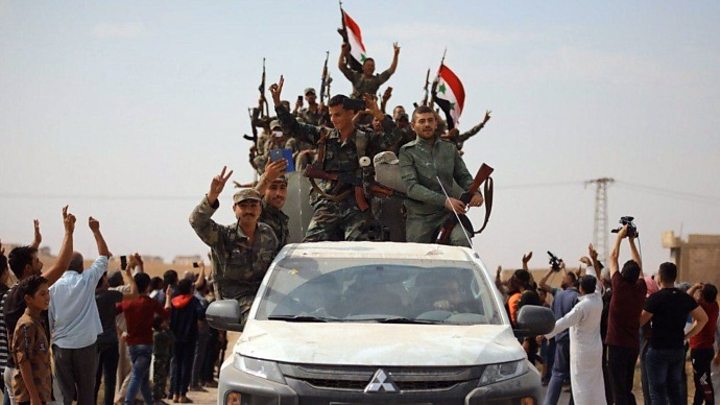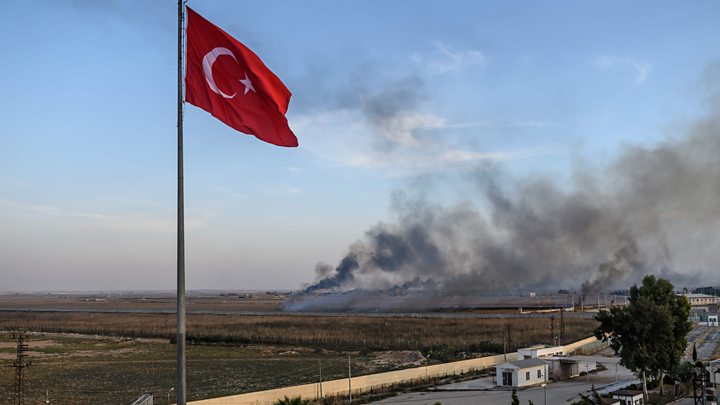Turkey-Syria offensive: Russia vows to prevent clashes with Assad forces
Moscow says it will not allow fighting between the two, amid Turkey’s offensive in northern Syria. …


Media playback is unsupported on your device
Russia has said it will not allow clashes between Turkish and Syrian forces, as Turkey’s military offensive in northern Syria continues.
“This would simply be unacceptable… and therefore we will not allow it, of course,” said Moscow’s special envoy for Syria, Alexander Lavrentyev.
The withdrawal of US troops from the region, announced last week, gave Turkey a “green light”, critics say.
Russia is a key military ally of Syrian leader Bashar al-Assad.
Russia’s defence ministry said its forces, which have been deployed in Syria since 2015, were patrolling along the “line of contact” between Syrian and Turkish forces.
What did Russia’s Syria envoy say?
During a visit to the United Arab Emirates, Mr Lavrentyev described Turkey’s offensive as “unacceptable”.
He said that under previous agreements Turkey can only go 5-10km (3-6 miles) into Syria – far less than the 30km “safe zone” Ankara is proposing – and that Turkey has no right to permanently deploy its troops in the country. Syria is in contact with Turkey to avoid a conflict, he said.
Mr Lavrentyev also confirmed that Russia had helped to broker a deal between Kurds and Damascus that saw Kurdish-led forces cede territory to Syrian government troops in return for military support.
How did we get here?
The Turkish offensive, which began last week, aims to push the Kurdish-led Syrian Democratic Forces (SDF) from the border region. Turkey considers the biggest militia in the SDF a terrorist organisation.
The Turkish government wants to create a “safe zone” in the area, where it can resettle Syrian refugees currently in Turkey.
Many of them are not Kurds and critics warn this could lead to ethnic cleansing of the local Kurdish population.
Dozens of civilians have been killed in the operation so far and at least 160,000 have fled the area, according to the UN.
Kurdish-led forces have been a key ally of the US in the fight against the Islamic State (IS) group in Syria. They described the US withdrawal, which preceded Turkish action, as a “stab in the back”.
There are fears the destabilisation could risk a resurgence of IS, as thousands of former fighters and their relatives are being detained in northern Syria. Hundreds of IS family members are said to have already escaped from one camp.
Turkish President Recep Tayyip Erdogan insists the operation will continue until his country’s “objectives have been achieved” despite the involvement of Syrian government forces.
The US has imposed sanctions on Turkish ministries and senior government officials in response to the country’s military offensive in northern Syria.
President Donald Trump also phoned his Turkish counterpart to demand an immediate truce, Vice-President Mike Pence said.
Mr Pence said he would travel to the region “as quickly as possible”.
What is happening in Syria?
Following the deal with Kurdish-led forces, the Syrian army began to move towards the border on Monday.
The deal is seen as a boost for Syrian President Bashar al-Assad as it meant his troops would return to north-eastern areas for the first time since 2012, when their withdrawal to fight rebels elsewhere allowed Kurdish militias to take control.
Despite disagreeing with their attempts at self-rule, Mr Assad did not seek to retake the territory, especially after the Kurds became partners in the coalition against IS with US troops on the ground.
Apart from fighting IS, the Kurds were fundamental to the US in limiting the influence of rivals Russia and Iran and keeping some leverage on the ground.

Media playback is unsupported on your device
Syrian government forces have entered the strategic town of Manbij, inside the area where Turkey wants to create its “safe zone”. Turkish troops and pro-Turkish, anti-government fighters had been gathering near the town.
For now, Syrian forces will not be deployed between Tal Abyad and Ras al-Ain, where Turkey has focused its efforts.
Why does Manbij matter?
Turkey has threatened the city since Kurdish-led forces liberated it from IS in 2016. Manbij lies close to the border, and Turkey counts the Kurdish militias in Syria as terrorist organisations.
Over the past two years, hundreds of US troops have visibly patrolled the streets of the city.
In March 2017, the Pentagon deployed soldiers to the area – and unlike in other parts of Syria, they flew US flags from vehicles to visibly deter a Turkish operation and reassure both sides. It was on such a patrol that a suicide bomber killed four US soldiers in Manbij earlier this year.
But the deployment has now come to a rapid end. On Tuesday, US military spokesman Col Myles B Caggins wrote on Twitter: “Coalition forces are executing a deliberate withdrawal from northeast Syria. We are out of Manbij.”
Syrian government forces and their Russian allies have quickly moved in.
A video posted on Twitter shows a Russian war reporter inside what was the US military camp, with equipment seemingly abandoned in the rush to leave the area.
According to the Russian defence ministry, Syrian government forces have now taken control of more than 1,000 square kilometres around Manbij.
Photos from the scene show military vehicles flying both Syrian and Russian flags entering the city.
It marks a dramatic change in the Syrian civil war, just over a week after President Trump announced a US troop withdrawal from the border.
What is the humanitarian situation?
International medical charity Médecins Sans Frontières (MSF) has announced a staff and operation pull-back in north-east Syria.
“The latest developments have only increased the need for humanitarian assistance, yet it is impossible to deliver it with the current insecurity,” said MSF emergency manager Robert Onus.
“It is with a heavy heart that MSF has taken the difficult decision to suspend the majority of our activities and evacuate our international staff from northeast Syria.”




